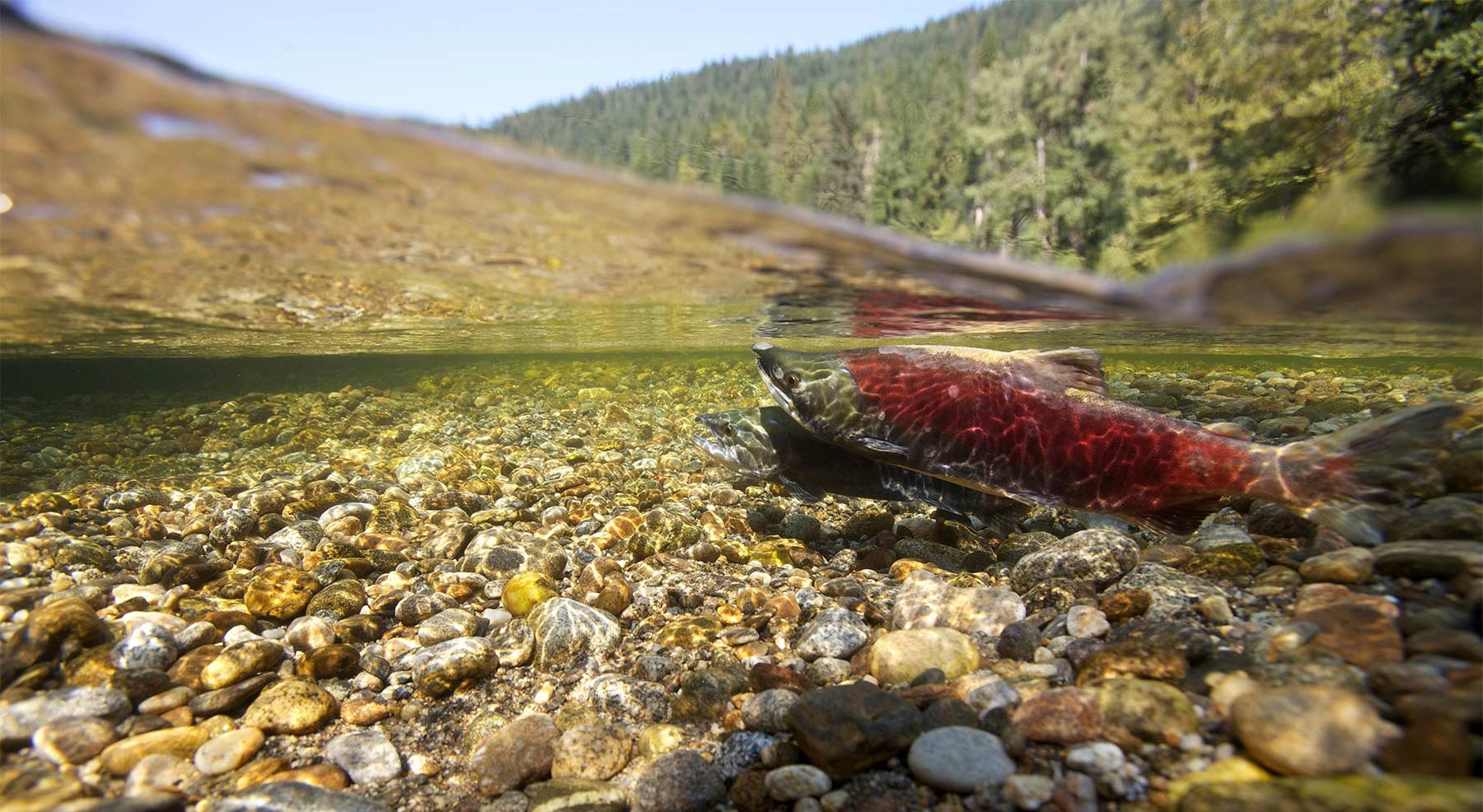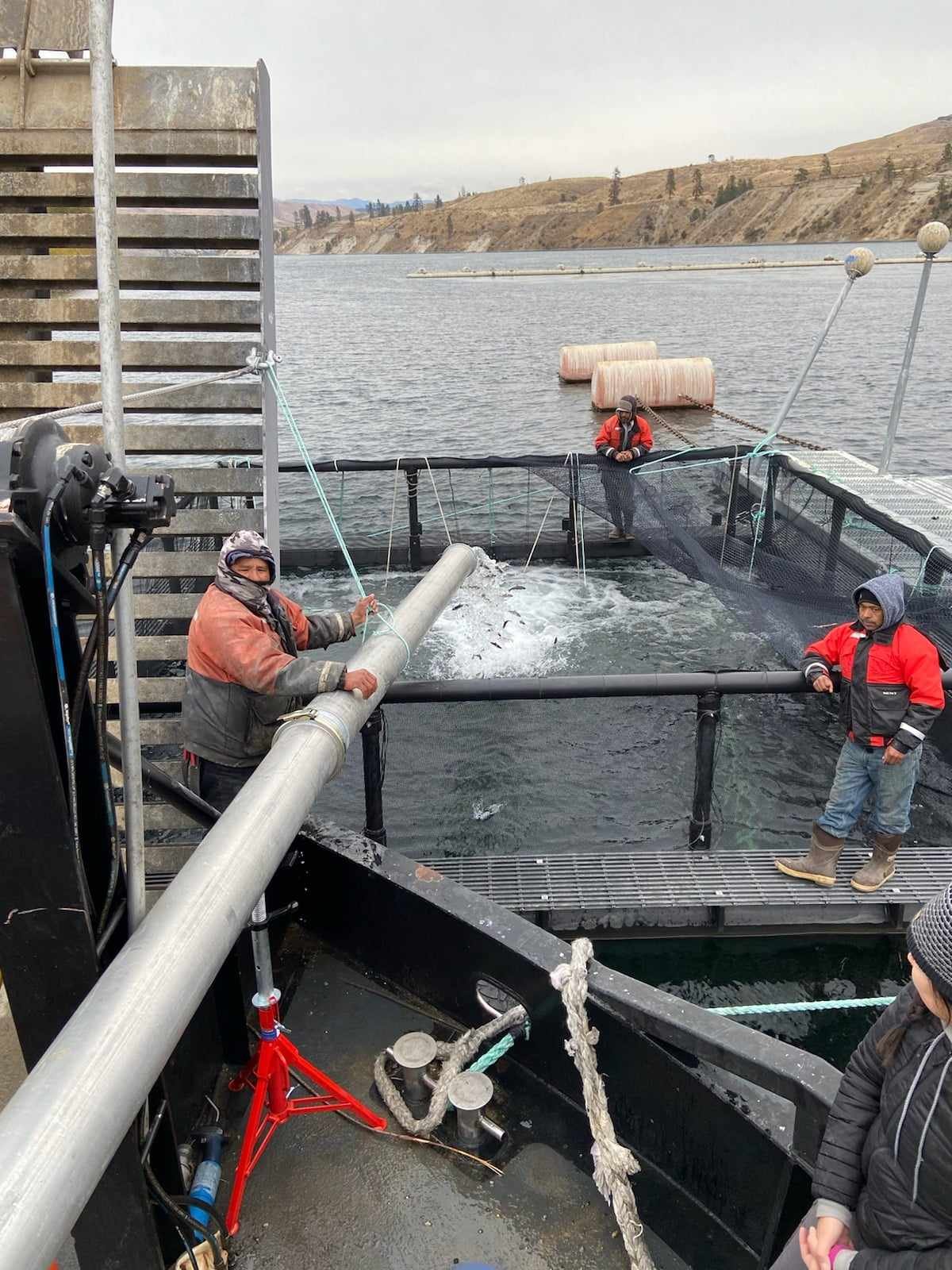
Programmatic Environmental Assessment for Phase 2 Implementation Plan: Testing Feasibility of Reintroducing Salmon in the Upper Columbia River Basin
Welcome
Photo credit: Upper Columbia United Tribes
Welcome to the Phase 2 Implementation Plan Programmatic EA Site
The Phase 2 Implementation Plan (P2IP): Testing the Feasibility of Reintroducing Salmon in the Upper Columbia River Basin is a 20-year plan for testing the feasibility of reintroducing Chinook and sockeye salmon into blocked areas upstream of Chief Joseph, Grand Coulee, Little Falls, Long Lake, and Nine Mile dams. These dams were constructed without fish passage, and the extirpation of anadromous fish in the blocked areas affected ecosystems and Tribal traditional and cultural practices related to salmon. The P2IP was developed by the Confederated Tribes of the Colville Reservation, Coeur d’ Alene Tribe of Indians, Spokane Tribe of Indians, and the Upper Columbia United Tribes (Project Proponents). The Project Proponents’ objective is to complete juvenile and adult salmon studies, develop fish rearing, and acclimation facilities, test the feasibility of fish passage options, and develop a long-term salmon reintroduction plan to serve the following goals:
Restore Tribal traditional and cultural practices related to salmon in the region.
Restore access to salmon for Tribal and non-Tribal communities in the blocked area.
Return salmon to their historic habitats in the Upper Columbia River to increase the abundance and distribution of salmon in the Columbia River Basin.
Restore ecosystem function in blocked area habitats as it relates to the cycling of marine-derived nutrients that anadromous salmon provide.
Before non-indigenous contact, millions of salmon returned to the Columbia River, were vital to a healthy ecosystem, and sustained tribal communities for many thousands of years. The construction of the five dams halted anadromous salmon passage to the upstream blocked areas and severely restricted or eliminated Tribal traditional and cultural practices related to salmon. Beginning in 2013, a coalition of Columbia Basin Tribes and Canadian First Nations jointly developed a four-phase approach to guide the development of fish passage and reintroduction efforts in the Upper Columbia above Chief Joseph and Grand Coulee dams. Upper Columbia United Tribes (UCUT) completed the Fish Passage and Reintroduction Phase 1 studies in 2019 in coordination with the state of Washington, the U.S. Geologic Survey, and other partners. UCUT developed the Phase 2 Implementation Plan based on the favorable findings of the Phase 1 studies, indicating that reintroduction is viable for the species evaluated.
The Bureau of Reclamation (Reclamation), Bonneville Power Administration (Bonneville), and the U.S. Army Corps of Engineers (USACE) (Co-lead Agencies), in cooperation with the Project Proponents, have prepared a draft programmatic environmental assessment (PEA) for the federal support of the P2IP as co-lead agencies. The P2IP involves activities over an approximately 20-year period to test key biological assumptions through salmon research studies, develop interim hatchery and passage facilities, establish sources of donor and brood stocks for reintroduction, and evaluate success. The draft PEA is available on the Bureau of Reclamation's web page at https://www.usbr.gov/pn/programs/p2ip/docs/DraftP2IP-PEA.pdf.
The Project Proponents are currently implementing juvenile survival outmigration studies. The applicable agencies have approved and permitted these activities, which are expected to continue under the No Action Alternative.
Photo credit: Confederated Tribes of the Colville Reservation Fish and Wildlife Department, CTCR Fisheries Researcher Casey Baldwin, releasing juvenile Chinook salmon for P2IP studies.
2023 installation of the pier nose trolley receiver equipment at Grand Coulee Dam for P2IP. Photo Credit: Devan Black, Reclamation, CPN Region, Grand Coulee Power Office.
Juvenile salmon being released into net pens for acclimation at Lake Rufus. Photo Credit: Coeur d’Alene Tribe
The Co-lead Agencies developed this PEA to evaluate the prospective environmental effects of federal actions associated with the P2IP, in accordance with applicable laws, regulations, and authorities. In late 2023, the Confederated Tribes of the Colville Reservation, Spokane Tribe of Indians, and the Coeur d’Alene Tribe and the federal government agreed to pursue a proactive, collaborative, and science-based approach to implementing the P2IP. The P2IP Agreement outlines funding and implementation commitments through the year 2043, including the following:
Bonneville will provide certain funding for implementation of the P2IP studies for reintroducing specific non-federally protected salmonid stocks above Chief Joseph and Grand Coulee dams in the Upper Columbia River Basin consistent with the Administrator’s settlement authority described under 16 U.S.C. § 832a(f). Consistent with the P2IP Agreement, Reclamation, USACE, U.S. Fish and Wildlife Service (USFWS), and National Marine Fisheries Service (NMFS) will work with Project Proponents and Bonneville to identify additional funding needs for implementation of P2IP and seek additional funding as necessary and appropriate to ensure full funding of P2IP activities during the 20-year implementation period.
Project Proponents may use existing hatchery facilities for activities related to P2IP implementation.
The USFWS may provide surplus fertilized eggs and juvenile and adult salmon of non-listed stock from federal hatchery facilities to support the study and testing of reintroduction.
The P2IP Agreement also establishes a mutual understanding that the Parties do not intend for P2IP implementation to require any material changes in operation and maintenance of any Columbia River System (CRS) dams or reservoirs and if material operations and maintenance changes were proposed, they could be subject to the completion of requisite compliance.
The federal government seeks to achieve the following purposes:
Support efforts to study and test the feasibility of reintroducing specific non-federally protected salmonid stocks above Chief Joseph Dam, Grand Coulee Dam, and Avista Corporation’s Spokane River dams in the Upper Columbia River Basin consistent with the P2IP Agreement.
Continue to provide adequate, efficient, economical, and reliable power supply.
Continue to deliver reliable water supplies, manage flood risk, provide reliable navigation, and support recreation opportunities.
Minimize environmental impacts.
P2IP Study Location and Alternatives
No Action Alternative
The No Action Alternative represents the continuation of ongoing P2IP activities, which are partially funded by the Co-lead Agencies. Where required, the Co-lead Agencies have already completed environmental compliance for the various study activities associated with the P2IP, including issuing required permits. The No Action Alternative provides the basis for comparison with the action alternative (here, the Proposed Action). The ongoing P2IP activities include collecting and transporting eggs and juvenile and adult salmon from existing hatcheries; fish rearing at existing hatcheries, net pens and acclimation sites; tagging and releasing juvenile and adult salmon; operating and maintaining previously installed P2IP receivers; and monitoring released salmon (see comparison of alternatives table).
Under the No Action Alternative, the federal actions to support the P2IP as described in the Proposed Action would not occur.
Photo of salmon egg processing. Photo Credit: Confederated Tribes of the Colville Reservation
Proposed Action
The Proposed Action would provide federal funding and authorizations to support a 20-year study to test the feasibility of reintroducing salmon in the blocked area through juvenile and adult salmon research studies; the development and operation of fish holding, rearing, and acclimation facilities; and the development, testing, and operation of interim fish passage systems (see comparison of alternatives table).
Federal actions may include but are not limited to the following:
Providing federal funding to support P2IP activities throughout the Study Area.
Reviewing, approving, and issuing permits for actions including, but not limited to, data collection, installation of equipment, or construction of facilities (for example, interim passage and/or rearing facilities) on federally managed lands and facilities.
Providing eggs, juveniles, and adult salmon from existing hatcheries and non-hatchery collection actions.
Participating in the planning, design, development, implementation, feasibility assessments, and operation of interim passage facilities and guidance structures.
Comparison of Alternatives
Proposed Action Activity Types
For more information on the P2IP PEA, please contact Melissa Yenko (myenko@usbr.gov).










